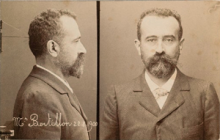Article
A formal portrait that usually pairs a frontal and a profile image capture of an individual's head and shoulders. First used in the mid-nineteenth century, mug shots, or face shots, were initially intended to reveal physiognomical characteristics shared by "degenerate" human beings, characteristics that were once believed to identify, measure, and statistically quantify those individuals, or groups, with criminal potential. Of course, many of the characteristics "revealed" by mugshots were actually created by the "scientific" process itself, a solipsistic arrangement called a "closed problem." A closed problem refers to a set of circumstantial evidence where the "solution" determines what the question, or problem, is. For example, if mug shots of criminals tend to show lower class, uneducated, males with short hair and dirty faces, then all lower class uneducated males with short hair and dirty faces must be criminals.
This type of visual profiling, which exists today, was also use to scientifically justify the differentiation between classes, races, ethnicities, and genders. With a middle class white (Caucasian) male serving as the normative example, anyone who deviated from being white, middle class, and male was by default degenerate and more than likely criminal.
"Self portrait of Alphonse Bertillon, creator of anthropometry, or the standardization of the mugshot photograph, August 22, 1900" by Alphonse Bertillon is licensed under Public Domain.
Manuscripts
References
Finn, Jonathan M.
2009 Capturing the Criminal Image: From Mug Shot to Surveillance Society. Minneapolis, Minn: University of Minnesota Press.
Rony, Fatimah Tobing.
1996 The Third Eye: Race, Cinema, and Ethnographic Spectacle. Durham, NC: Duke University Press.

